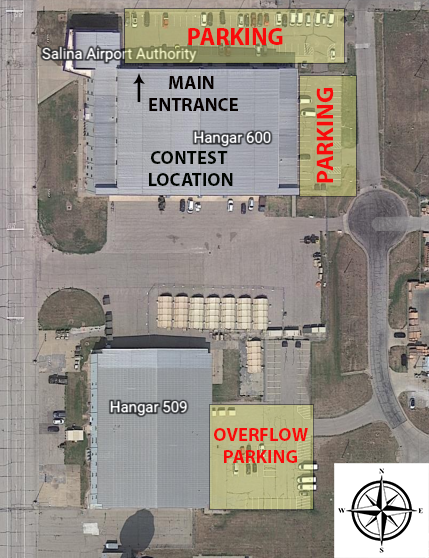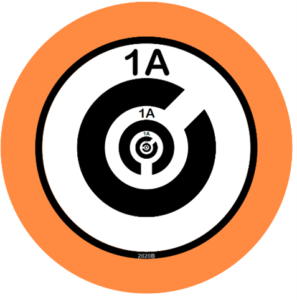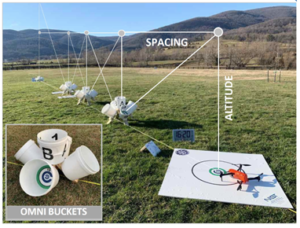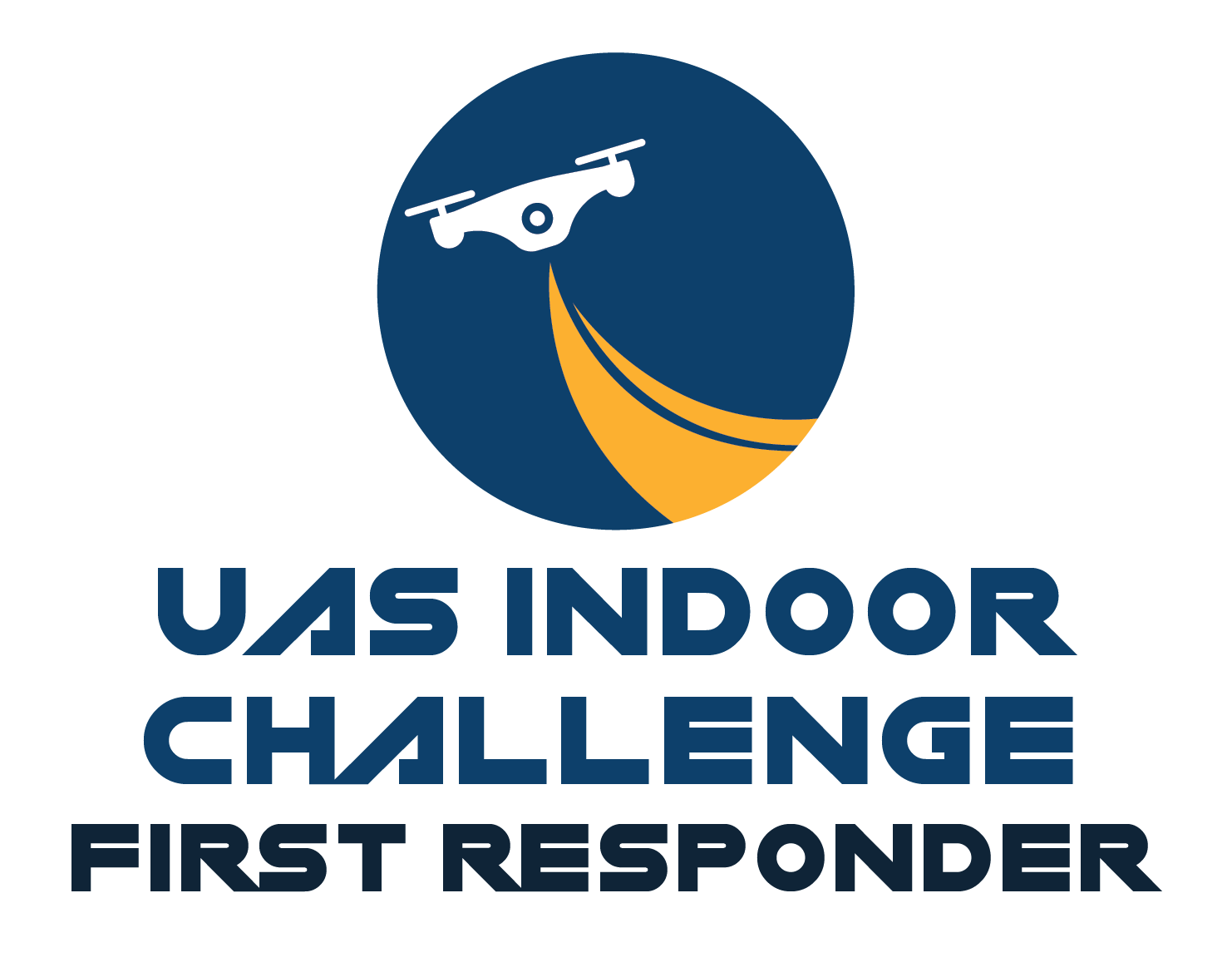Spectator Overview and Expectations
The following information is provided to event spectators for the First Responder UAS Indoor Challenge (UAS 4.0).
Spectators must check in at the registration table located at the building entrance to receive a temporary event badge. All spectators must read and agree to safety terms prior to being released to the viewing area.
General Schedule
Spectators will be permitted to view the event in the afternoon on Tuesday, May 2nd, all day Wednesday, May 3rd, and the morning of May 4th. . More information about the challenge and the requirements are provided further below.
Contest Location
The contest will be held at Hangar 600 in the Salina Airport Industrial Park. Look for “Airport Event” banners and signs directing towards Hangar 600. Check-in is located on the north east building entrance.
GPS Address: 2720 Arnold Ave, Salina, KS 67401
Driving Times from Area Airports:
- Salina, KS: about 10 minutes, limited daily flights
- Manhattan, KS: about 1 hour
- Wichita, KS: about 1.5 hours
- Kansas City, MO: about 2 hours
Parking
Parking is allowed in lots as identified on the image below. No parking pass is required.

Contestant Amenities
Wireless internet is available in the facility at no cost using the following login:
Account Name: KSU Guest – no password is required.
Facility and Contest Event Map
Live Event Facility Map [PDF]
Challenge Overview
Search and rescue (SAR) operations that occur in unfamiliar environments may present danger to first responders where they would benefit from situational awareness. For example, search and rescue operations (SAR) that take place in an indoor, constrained environment, such as a partial building collapse, require reliable tools to assess the risks to first responders and other SAR resources before entering the building. Those operating UAS indoors may also encounter obstacles, such as limited lighting and lack of global positioning system (GPS), which may require a different response to an incident. Certain scenarios can be life-threatening if humans are sent in first to assess the environment and provide information back to incident command before deploying other first responders on-site. At present, cost-effective unmanned aircraft system (UAS) solutions do not exist that gather information and promote safer initial response efforts while providing valuable intelligence.
The National Institute of Standards and Technology (NIST) Public Safety Communications Research (PSCR) division sought innovative UAS solutions to support First Responders by scouting an indoor structure and providing information about its condition and situational awareness prior to entry. The goal of this challenge is for contestants to design, build, and fly a cost-effective UAS that is easy to control, highly durable, and provide first responders with a high-quality video signal needed to detect human life and assess hazards in the environment. Improvements to UAS usability and flyability, along with more advanced autonomous sensors that operate with no GPS signal, will prove to help UAS operators or pilots save the lives of first responders and the community.
Teams competing today are in the running for the challenge prize. If awarded, funds are to help teams leverage their design into a commercial product for first responders.
Challenge Competition
Teams compete in the challenge by demonstrating their UAS solution performance. These are tested through five stages.
1. Safety Checks
All aircraft and ground-based equipment will undergo rigorous safety evaluations leading up to the Live Event. Physical inspections will take place before each flight. Before completing a review of the contestants’ prototype UAS will be performed to ensure it is compliant with standard safety practices and the competition rules. Full compliance is required.
2. Static Tests
Each team and UAS will be evaluated on the fixed attributes of the UAS: Systems will be measured and awarded points based upon the specific attributes associated with the requirements listed in the challenge rules. This includes but is not limited to:
- UAS Manufacturers Suggested Retail Price (MSRP)
- Real-time downlink video quality
- Video recording capability and quality
3. Technical Flight Evaluations
 Before entering the live scenario, each team must demonstrate their UAS prototype capabilities. Contestants will be provided with a series of flight maneuvers and will fly a defined route and complete a series of tasks. During the flight, the system will be evaluated and awarded points based upon performance associated with the requirements listed in the challenge rules. This includes but is not limited to:
Before entering the live scenario, each team must demonstrate their UAS prototype capabilities. Contestants will be provided with a series of flight maneuvers and will fly a defined route and complete a series of tasks. During the flight, the system will be evaluated and awarded points based upon performance associated with the requirements listed in the challenge rules. This includes but is not limited to:
- Deployment Time
- Flyability (Ease of Control)
- Ground Control Station
To evaluate the UAS performance, a variant of the NIST Open Test Lanes has been implemented. The Open Test Lanes use buckets with targets inside. The UAS operator must maneuver the UAS in position to accurately read the target and relay the information. Correctly identifying the targets from varying positions and angles helps determine the quality of the UAS and sensor, while speed helps determine the quality and flyability of the system. Overall accuracy and speed determine the teams score.
4. Live Indoor Flight Scenario
 During the simulated indoor mission, contestants will put their system into operation from a stored, packaged state and fly their UAS into a simulated indoor mission. During the simulated indoor mission, contestants and the system will be evaluated and awarded points based upon performance associated with the requirements listed within the challenge rules. These include but are not limited to:
During the simulated indoor mission, contestants will put their system into operation from a stored, packaged state and fly their UAS into a simulated indoor mission. During the simulated indoor mission, contestants and the system will be evaluated and awarded points based upon performance associated with the requirements listed within the challenge rules. These include but are not limited to:
- Deployment Time
- Ease of Operation
- Real-Time RGB Video
- Flyability (Ease of Control)
- Flight Time
- Ground Control Station Capability
Teams will fly their UAS prototype into a simulated partially collapsed building. They will be tasked with identifying targets within the collapsed environment. Targets are a combination of stranded humans and NIST bucket targets. The environment within the simulated collapsed building gets progressively harder by means of reduced lighting, increase of debris, and further constrained access. Teams are awarded points on how many targets they can reach and identify with their UAS.
5. Additionally Preferred Capabilities
 In the operational environment, situational awareness is critical. However, additional capabilities add costs and increase weight. Contestants will be awarded extra credit points by demonstrating any additional capabilities within their UAS design. UAS solutions will be measured and awarded points based upon the specific attributes associated with the requirements listed in the UAS Design Specification. These include (but are not limited to) the following:
In the operational environment, situational awareness is critical. However, additional capabilities add costs and increase weight. Contestants will be awarded extra credit points by demonstrating any additional capabilities within their UAS design. UAS solutions will be measured and awarded points based upon the specific attributes associated with the requirements listed in the UAS Design Specification. These include (but are not limited to) the following:
- Thermal (Infrared)
- Night Vision
- Audio
- Auto-Flip (Turtle)
NIST Indoor Challenge Link: https://www.nist.gov/ctl/pscr/open-innovation-prize-challenges/current-and-upcoming-prize-challenges/2022-first-responder



